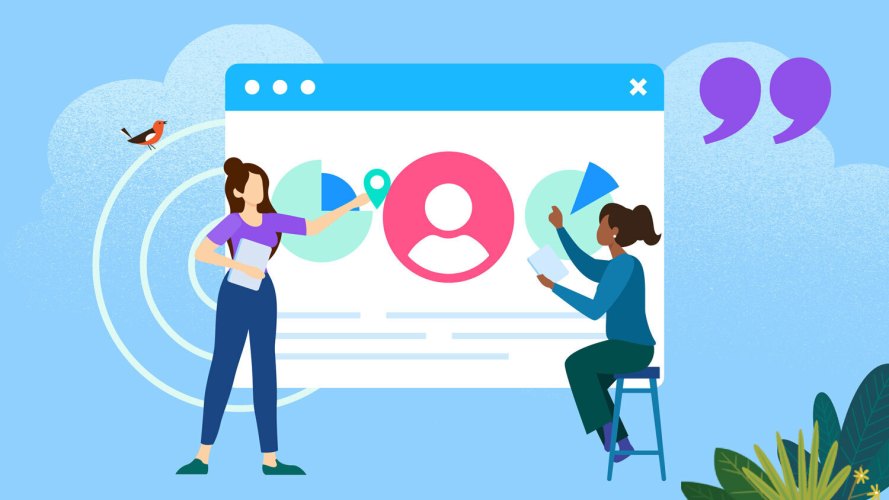Imagine your ideal customer. If this conjures a blurry image in your mind, it’s time to refine your buyer persona. A strong buyer persona dives deeper than just demographics; it uncovers the motivations, needs, and desires that drive your target customer.
What do they wake up thinking about? What makes them excited or scared? How do they collaborate with their colleagues? Understanding this psychological core can transform your marketing strategy and help you connect on a deeper level, allowing you to focus on the right customers and grab them with sales messaging that resonates and sells. Here’s how.
What you’ll learn:
- What is a buyer persona?
- Key benefits of buyer personas
- Creating a buyer persona
- Advanced techniques for creating buyer personas
- Common mistakes and how to avoid them
- Integrating buyer personas into your sales strategy
Make your enablement about results, not effort
Close your revenue gaps and get more out of every rep — with Sales Programs delivered in your CRM.



What is a buyer persona?
A buyer persona describes a specific type of customer. It provides demographic traits like their role and company and includes psychological traits like motivations and challenges. Sellers create buyer personas using data, research, and interviews — and use them to determine whether a customer is the right fit for their product or service.
- A positive buyer persona describes personas who are an ideal customer, which means they are motivated and more likely to purchase your product or service.
- A negative buyer persona describes personas who aren’t great fits for your solution, which means they’re more likely to be difficult to work with, end the relationship early, or not buy altogether.
Key benefits of buyer personas
It’s not your job to convince the customer to say “yes.” It’s your job to find a customer who’s a great fit, so much so that “yes” is the most natural thing in the world. A buyer persona helps you target the right customers, increasing your chances of closing deals fast.
These are some other benefits of creating buyer personas:
- Adds value: Buying personas don’t just help the sales team. They can also be leveraged by other departments like marketing, customer service, or product development to help them better understand the company’s customers so they can provide informative interactions with them.
- Enhance personalized communication: A seller can add a relevant and tailored angle to emails or other outreach so that it resonates with a prospect’s needs. By focusing on the individual’s preferences, a seller can understand and empathize with a customer’s unique needs and expectations.
- Uncover new lead sources: By identifying your ideal customer, you may find a new industry or role to target for leads. For example, a recruitment software company may be targeting human resources at healthcare corporations and discover new opportunities in financial services.
You’ll know your buyer personas are working if you’re getting better results with the same amount of work — whether it’s booking more meetings with the same amount of outreach, or closing more deals from the same number of conversations. Sales performance can be tracked in the analytics dashboard of your customer relationship management (CRM) platform.
Creating a buyer persona
Create buyer personas from the outside in. First, use data and research to fill in traits you might see on a resume. Then, use interviews to go deeper into the psyches of your target customers and discover the things they care about most.
Here is how to create and implement a buyer persona:
1. Use data and research to fill in demographic traits
A buyer persona should begin with the basic work-life characteristics of your ideal customer (demographic traits). Knowing these traits makes it a lot easier to go over a large volume of leads and identify which prospects to focus on, and which to rule out. Keep in mind that leaning too much on demographic data might rule out great potential customers who come from diverse and underrepresented backgrounds.
Here’s a starter list of traits to look for:
- Title and role
- Company size
- Income level
- Industry
- Region
- Gender
- Age
- Marital status
- Job history
- Education
- Community groups
Use research and data to fill in the outline of your ideal customer. If you already have a sales plan, then start there. You should also have useful data in your CRM system, which includes demographic information on past customers.
From there, round out your understanding with research. Look through company presentations and customer stories, and go online to search for additional information. For example, you might track down buyer personas that other companies have created, then search for target customer titles on LinkedIn and in analyst reports.
Let’s imagine that you are a sales rep for Fancy Designs, a company that specializes in website development software that allows organizations to create professional-looking websites without the need for a developer. Your buyer persona is the Chief Marketing Officer (CMO). After digging into your data and doing research, you might discover that a lot of CMOs have about 15 years of experience, hold a bachelor’s degree, and work at companies with more than 100 people.
To anchor your imagination and bring your buyer persona to life, let’s give her a name: CMO Melissa.
2. Use research and surveys to understand their job descriptions
Now it’s time to understand the daily work of your buyer persona. Your objective is to discover the elements of their job description so you can speak more intelligently to their goals. These elements include:
- Daily responsibilities
- Professional challenges
- How they define success
- Skills required for success
Searching through job listings is a great way to discover this information. You can also send surveys to current customers with this role. If you don’t have any, consider sending surveys to targets who fit your existing demographic data, offering them an incentive for participating. The incentive could be a gift card, discount offer, or entry into a prize raffle.
For example, you might reach out to CMO Melissa, reframe the categories above as questions, and ask her to list her top responses. For example: “What are your top two job responsibilities?”
3. Use interviews to understand their psychology
Now’s the time to get even more personal and discover your buyer persona’s underlying drivers so you can attract them with relevant, personal messages. You’re on a mission to discover:
- Methods of learning
- Motivations
- Challenges
It’s time to go to the source. Actually, there are two sources: subject matter experts who know this persona inside and out, and target customers themselves. Schedule interviews with product people and sellers from within your company who can tell you the kinds of people who are the best fit for your offering.
Then, find a group of customers who are willing to sit down with you for a conversation. Ask your sales team to recruit customers during sales calls and meetings. If your base of customers isn’t large enough (or if you’re having trouble getting people to agree to chat) then expand your search to include prospects.
Draft questions that touch on the three bullets above and keep them brief. Consider including polls in your interview as well, so you can group responses into data points. If you have a large enough number of respondents, group them based on categories like industry, geography, and seniority so you can find similarities and nuances within each group.
Returning to CMO Melissa, you might discover that she’s motivated by having the latest technology to engage with her customers, such as website chatbots and AI content generation. You might also discover that this is one of the most high-pressure jobs in the C-suite, and it takes a certain kind of person to withstand that pressure and keep going.
4. Create a buyer persona that’s easy to reference
A buyer persona brings all your valuable research together into one succinct place, so you can reference it while prospecting and selling. Often, the buyer persona is organized like an infographic, with insights and bullets that you can easily skim. A buyer persona may feature a photograph or illustration, a name, and a brief biography detailing their primary characteristics, challenges, and objectives.
Some companies expand their buyer personas into presentations with multiple slides so they can expand on their research in greater detail. Whatever format you choose, make it consistent across all the buyer personas in your company so sellers can quickly find the information they need.
Here’s an example of a buyer persona for CMO Melissa:
Responsibilities
- Execute a marketing strategy
- Grow and mentor marketing talent
Skills required for success
- Calm under pressure
- Ability to collaborate with other executives
Methods of learning
- Conversations with peers
- Industry content like marketing reports
Motivations
- Using new technologies
- Personal recognition
Challenges
- Getting buy-in from executives
- Retaining talent
5. Use buyer personas early and often, and update them as you go
Make buyer personas a part of your sales enablement program and pull them up before every customer interaction, from email outreach to calls and meetings, to remind yourself of your buyers’ needs and preferences. For instance, if you’re calling on a prospect who fits CMO Melissa’s buying persona, you may focus the meeting on your product’s new technologies.
Be sure to revisit your buyer personas and update them periodically. You’ll want to especially prioritize this when there are shifts in your business, market changes, or you notice new types of customers becoming interested in your product. That way, your buyer personas will remain relevant and valuable.
In the example we used previously, this might look like Fancy Designs noticing a surge in new clients with creative services titles who are using their software. In response, the business develops a new buyer persona to cater to this emerging segment.
Don’t forget to loop in other teams as soon as your buyer personas are ready. For example, the product team can use buyer personas to ask follow-up questions, and the marketing team can use them to test new messages in advertising or gauge interest in a new event.
Advanced techniques for creating buyer personas
Your sales team will acquire more customers as your company grows and scales. When this happens, you may need some advanced techniques to build upon your existing buyer personas to cover your newer customers. A good place to start is by getting a better understanding of the entire customer journey prior to a purchase decision. Examine the process through which customers make purchasing choices and gain insights into the nuances of your buyer personas. Then, put a plan in place to leverage your personas to their greatest potential.
- Use data from social media platforms: Social media platforms provide valuable insights into the interests and perceptions of your target audience, as well as those of your brand and its competitors. Use social listening tools to monitor and analyze social media conversations and discover mentions in the content. This approach ensures that your buyer personas are based on authentic information that may not be captured through traditional survey methods.
- Apply psychographic profiling: This method involves exploring the psychological characteristics of the audience, including their values, attitudes, interests, and lifestyle preferences. The approach can offer profound insights into your buyer profiles by utilizing tools such as surveys, interviews, and social media analysis to delve deeper into the motivations behind your customers’ behavior.
- Integrate data from existing tools: Explore the data from tools such as your CRM, website interactions, customer service feedback, and email marketing campaigns.
- Collaborate across departments: Gather your sales, services, and marketing teams to engage in cross-departmental workshops about buyer personas. Share your insights on buyer characteristics and preferences and learn from others.
Join the Salesblazer movement
We’re building the largest and most successful community of sales professionals, so you can learn, connect, and grow.

Common mistakes and how to avoid them
The development of your buyer personas should strike a careful balance between being too broad or too narrow. Should your buyer personas be overly broad, there may be a scarcity of actionable information. Conversely, if the persona is too narrowly defined, significant business segments could be overlooked. For example, a broad buyer persona would be “every CMO in the eastern United States” and a narrow buyer persona would be “CMOs in Massachusetts with teams of two people.”
Here are some other mistakes to avoid when creating your buyer personas:
- Avoid bias: Remain vigilant against creating personas built on unfounded assumptions. During customer interviews, speculations must be substantiated to ensure that the buyer personas accurately reflect the typical customer. Also, do not make guesses about buyers based on age, generation, or other stereotypes.
- Maintain accuracy: An inaccurate portrayal of a buyer persona can affect how a sales team prioritizes their targets. Although sellers know they need to regularly update their buyer personas as the business evolves, many forget, and it impacts the accuracy by not having the latest information. Set buyer persona update reminders in your CRM.
- Not creating negative buyer personas: Sometimes, sales teams become so focused on their ideal customer that they overlook including negative buyer personas in their process. This approach wastes sellers’ time by pursuing customers that will likely not convert. Start by researching customers that had low satisfaction with your company to determine why they were not the right fit.
Integrating buyer personas into your sales strategy
According to the Salesforce State of Sales Report, buyers expect personalized engagement focused on their individual needs and preferences. 86% percent of business buyers say they’re more likely to buy when their goals are understood, yet 59% of business buyers say most reps don’t take the time to understand their goals.
By integrating buyer personas into your sales strategy, you’ll drive more sales because your sales team will be equipped with content tailored to each persona and focused on their unique needs and objectives. Consider creating a content library in your CRM that includes sales scripts, conversation guides, case studies, and product demonstrations that are curated to meet the specific requirements of each persona. Your customer engagement will be enhanced as the relevant content resonates with your buyer.
Lead scoring, a method used to evaluate the quality of leads and prioritize your sales team’s efforts, can be used to assign values to positive and negative buyer personas. Leads can then be given to each sales rep and divided into customer segments, such as industry or territory.
Start to find your ideal customers with buyer personas
By adding buyer personas to your sales strategy, you will develop a thorough understanding of your ideal customer, including their demographics, motivations, and challenges. You can take this essential information and pursue customers that want and need your product or service. You’ll deliver personalized and relevant interactions that resonate.
Tee up for success
See how Sales Programs from Sales Cloud helps reps win more — and win bigger — within the flow of work.





























